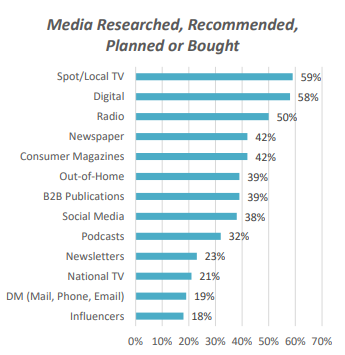Study: media planners/buyers are busier, reluctant to return to the office


Media planners and buyers have reported a surge in workload during the pandemic, alongside a reluctance to return to the office.
In 2022, 63% of media planners/buyers work on five or more clients and five or more brands, according to findings from SRDS and the James G. Elliot Co.
The numbers show an increased load, from three or four clients and four or more brands as reported in their 2019-2020 study.
The study also found that it’s “always planning season”, as just 23% of media planners plan annually and 38% plan quarterly.
The study included 104 participants out of a population of 4,124 SRDS subscribers. Job functions represented in the survey include: media buying & planning (31%), media planning (22%), media buying (17%), account management 6%), and executive management (4%).
Currently, spot/local TV (59%), digital (58%), and radio (50%) are the media types most researched, planned, or bought in the US, according to the study.

Additional findings from the study showed that RFPs are still consistently in use – 63% of buyers always or often use them, and 91% of respondents say request for proposals from advertisers (RFPs) are important to the planning/buying process.
However, planners/buyers do not allow much time for RFP response, with a median wait time of five days (and a mean of 6.1).
Another key takeaway, just 16% of media sellers are always or often given a chance to change proposals that were not accepted.
The study also examined work norms in a post-pandemic labor environment. Regarding work-from-home or hybrid office models, over a third (36%) of planners/buyers expect to be working remotely full time, and more than half (58%) expect a hybrid arrangement going forward.
Just 7% overall expect to be working full-time in office, though it’s worth noting there are differences depending on the size of the organization – while 15% of respondents working in offices with under 100 employees expect to return to full-time in-office work, 0% of respondents from offices larger than 100 employees said that would be the case.
As such, the importance of communication channels have changed, with respondents ranking email (95% important), virtual meetings (91% important), and telephone calls (84% important) more important channels than in-person meetings (63% important).
Editor’s note: SRDS is a sister company to The Media Leader; both are part of Adwanted Group.
